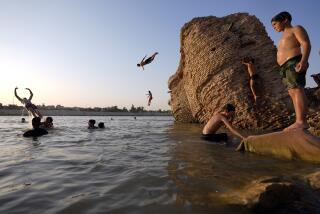Egypt Has Lofty Goals for Renewable Energy
HURGHADA, Egypt — European tourists step out of their planes expecting to see the turquoise water, rainbow fish and olive-green coral that make this Red Sea resort famous.
Instead, their first sight as they head for hotels is a throwback to home: windmills. It’s a wind farm with 40 high-tech windmills set on the desert in neat rows, their 33-foot blades ceaselessly spinning in the relentless breeze.
As wind farms go, Hurghada’s isn’t particularly impressive. Some windmills have three blades, others two. Some are too close to houses.
But the Egyptians have impressive hopes for this project. It is the pilot stage of a program aimed at making Egypt the No. 1 generator of wind power in Africa and the Middle East within two years.
Experts say this coast is among the world’s best sites for turning wind into electricity. The winds blowing across northern Egypt from the Mediterranean are accelerated by the high mountains along the Red Sea--in the same way that water velocity increases if you squeeze a hose.
Moreover, the wind is remarkably constant.
At places it averages more than 23 mph for 95% of the year. Some of the biggest European and American wind farms are sited where the average speed is 16 mph.
Egypt’s extra velocity is worth more than it seems. Because the electricity generated varies exponentially with speed, that extra 7 mph delivers almost a threefold increase in power.
“We are talking about ideal conditions,” said Amr Serag el Din, professor of mechanical engineering at American University in Cairo.
The proof is in the price. At Zafarana, the Red Sea village where the project is to be built, windmills are expected to generate power for 4 cents per kilowatt-hour. That is one-third the average cost in Germany, the world’s biggest generator of wind power.
The one environmental risk is to birds. About a dozen species, including white storks and steppe eagles, migrate in the thousands down the Red Sea corridor.
Richard Hoath, an ornithologist, said the threat is relatively minor because the birds fly about 125 feet above the planned windmills. But he said there should be no adjacent sewage plants or rubbish dumps that could draw the birds down into the path of the blades.
Egypt began looking at wind in 1986. It wanted to reduce the pollution produced from its natural gas- and diesel-fired power stations. The state’s New and Renewable Energy Authority began mapping winds across the country.
The readings from Hurghada were high. Then experts from DANIDA, the aid agency of Denmark--builder of the first wind farm in the 1890s and now the leading manufacturer of wind turbines--discovered even higher wind speeds at Zafarana.
Egypt’s government set aside 32 square miles of desert at Zafarana. Construction is to begin in December on Danish- and German-financed wind farms.
By the end of 2000, the farms should be generating 90 megawatts, enough to power a town of 15,000 people. That is 10 times the output of Iran, now the biggest wind power generator in Africa and the Middle East.
The renewable energy agency is negotiating with other countries about sponsoring wind farms and talking to foreign companies interested in building and running the farms for a profit.
Its vice chairman, Mohammed Aref el-Qarmalawy, hopes that windmills will be generating 600 megawatts by 2005--about 3% of Egypt’s needs. By today’s standards, that would make Egypt the world’s fifth-biggest producer of wind power, behind Germany, 2,080 megawatts; and the United States at 1,600 megawatts.
More to Read
Sign up for Essential California
The most important California stories and recommendations in your inbox every morning.
You may occasionally receive promotional content from the Los Angeles Times.










